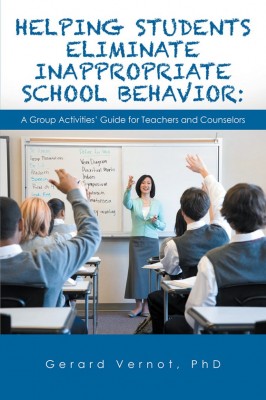 Dr. Gerard Vernot addresses student behavior as an encompassing issue that many are finding difficult to manage and provides strong solutions that are applicable to all. Helping Students Eliminate Inappropriate School Behavior does not seek to blame but instead inspires readers to push forward by providing realistic activities that are appealing to middle and high school students. This book incorporates many learning styles and needs with consideration of children’s developmental processes. With consideration given to different cultures, the material presented in this book encourages readers to understand their students beyond their behavior in the classroom. This approach shifts the focus of inappropriate behavior from the individual student to a systemic perspective. Dr. Vernot advocates for educators and counselors to recognize the needs of our students and to respond effectively to their needs by engaging and increasing students’ awareness.
Dr. Gerard Vernot addresses student behavior as an encompassing issue that many are finding difficult to manage and provides strong solutions that are applicable to all. Helping Students Eliminate Inappropriate School Behavior does not seek to blame but instead inspires readers to push forward by providing realistic activities that are appealing to middle and high school students. This book incorporates many learning styles and needs with consideration of children’s developmental processes. With consideration given to different cultures, the material presented in this book encourages readers to understand their students beyond their behavior in the classroom. This approach shifts the focus of inappropriate behavior from the individual student to a systemic perspective. Dr. Vernot advocates for educators and counselors to recognize the needs of our students and to respond effectively to their needs by engaging and increasing students’ awareness.
Dr. Vernot provides adaptable, evidence-based activities that create foundational structure. The activities included by Dr. Vernot are derived from the literature provide a foundational structure. Each activity provides detailed instructions that set up the structure of the activity, what is needed to make the activity successful, and how the facilitator can process after the activity. Clear directions and examples allow educators and counselors to efficiently and effectively decide the most appropriate activity for a student(s), meeting the demands of facilitators who use this resource on a daily basis. The activities included address a variety of behavioral concerns while helping students gain skills in areas of communication, cooperation, conflict management, and problem-solving techniques. These are crucial tools that we all aim for students to learn while in the academic setting, and these activities can provide additional support to teacher and counselors when structuring each class.
Although Dr. Vernot makes significant contributions by compiling a guidebook to address problematic behaviors, these activities alone will not change the behaviors. Crucial factors, such as familial support, environment, developmental level of the student, and systemic structures of the student’s school and culture, should be considered in addition to the intentional activities provided in the book. These considerations can holistically create the space for students to recognize their behaviors and empower change. Implementation of activities to address behaviors may not have a long-term success without initially understanding the development of the behavior.
The content addressed in this book can appeal to a variety of counseling professionals. Although the specific roles of school counselors, counselor educators, and Licensed Professional Counselors differ, each can find value in implementing the activities provided in their work with children and adolescents. These tools can be used to build foundational trust and rapport that is needed throughout the counseling profession. In addition, the activities suggested in this book can be seen as normal engagement by children and open the space for appropriate interaction with their peers, teachers, or counselors.
Vernot, G. (2016). Helping Students Eliminate Inappropriate School Behavior: A Group Activities’ Guide for Teachers and Counselors. Bloomington, IN: AuthorHouse.
Reviewed by: Jillian M. Blueford, NCC, The University of Tennessee, Knoxville
The Professional Counselor
